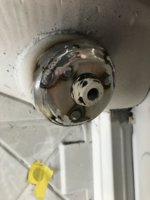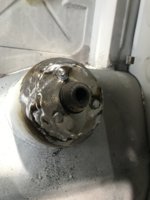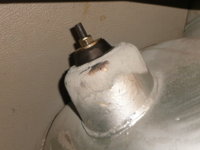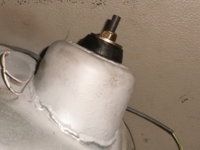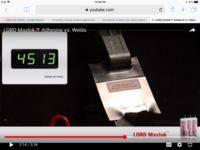No, the e3 mount is flat and has a plate with three bolts/nuts.
You are using an out of date browser. It may not display this or other websites correctly.
You should upgrade or use an alternative browser.
You should upgrade or use an alternative browser.
Heartbreak-broken rear shock mount
- Thread starter Stevehose
- Start date
While my body was in the cancer hospital I had my metal guy redo my towers. The left one broke as I was about to cross the Hudson River in NY in 2015. 1000 miles from home.
The right one was about to go he discovered when he started working on it.
The right one was about to go he discovered when he started working on it.
Attachments
restart
Well-Known Member
Automotive epoxy bonded to a large surface area like that would probably hold as good or better than a weld, without adding the rust prone areas that welds do. In addition, the "sleeve" would be added to the existing shock can from underneath so the original material would still be there and help hold it in place.
It would probably work just to bond a large washer on the underside of the top surface. That would probably transfer enough of the load to the outer edge and reduce the flexing.
I used some of the most toxic of modern panel adhesives in a different application and its amazing stuff. It has a lot of advantages over welding and from the tests I have seen is stronger than welding.
I used some of the most toxic of modern panel adhesives in a different application and its amazing stuff. It has a lot of advantages over welding and from the tests I have seen is stronger than welding.
Can you point us to the specific adhesive?
Can you point us to the specific adhesive?
I would believe that adhesive would only be better than welding in certain overlapping installations. I don't believe that any adhesive, gram for gram, has the same tensile strength as steel. The advantage you can get is that it can easily be applied along the entire join between two panels and thus give greater strength to the connection between them than a series of much smaller spot welds.
In the case of our shock towers, if you had a deep cup made that closely fit to the existing shock tower and the surfaces were properly prepared, you might get a sufficient bond using these new adhesives. That's a big if.
I would much rather have a beefy plate welded to the top of the tower. I would think it's better if it was dished a bit to reach further out over the edge a bit.
Yes, access is a bit difficult but it can be done. If there are speakers holes in the rear deck, that helps quite a bit.
Ian
restart
Well-Known Member
restart
Well-Known Member
Therepeated combination of shock tower and speaker hole in this thread made me think..
Are the said speaker holes cut in by owner? how many shock tower failures had speaker holes?
Are the said speaker holes cut in by owner? how many shock tower failures had speaker holes?
Last edited:
Shock tower failure unrelated to speaker holes, having holes allows easier access to weld the towers. Holes were either dealer or owner cut when a radio installed.
restart
Well-Known Member
My thought was that all that missing structure moves the stress down to the weakest link.
Just thinking out loud.
Just thinking out loud.
restart
Well-Known Member
Still curious how many shock failures had speaker cutouts. Tried searching around but it’s a rabbit hole.
While I certainly haven't studied this scientifically - no engineering models or stress diagrams - I don't think the stresses from the shock towers ever develop up into rear deck surface. I'd be surprised if the presence of a speaker hole would affect that domed tower metal. That's my 2-cents, anyway.
Last edited:
No speaker cutouts and yet...
Those videos support my statement that adhesives are superior to spot welds (or rivets) because the bond is spread across a large, uniform area. Certainly in the one video, using two spot welds is hardly a fair test IMO. No tests were done with a fully welded bead. Typically the weld material is chosen to have superior strength to most stock metals. Proper welds have strength greater than the stock material as well.
Unless a cup shape with large overlap is made for the shock tower repair, those conditions of large matched surfaces do not exist so adhesive would not be an appropriate repair. All the tests are along the plane of the metal, with a shock tower, you have a force at 90 degrees to the top surface, so the shear force on the adhesive would be at a maximum.
You could use adhesive to bond in new floor panels or firewall, if you had the replacement panels formed so that they would accurately match the existing metal and have a good overlap. Of course, it would be easily spotted as a non-original repair, so many would shy away from it on those grounds alone.
I'm all for such improvements for new vehicles, but isn't the point of owning a vintage car that fact that it's vintage and therefore different from all that comes later and has been cared for and restored as such? I'll make my repairs with a torch and they will be if not indistinguishable from factory welds, at least will be of the same caliber, look, and strength.
Ian
Unless a cup shape with large overlap is made for the shock tower repair, those conditions of large matched surfaces do not exist so adhesive would not be an appropriate repair. All the tests are along the plane of the metal, with a shock tower, you have a force at 90 degrees to the top surface, so the shear force on the adhesive would be at a maximum.
You could use adhesive to bond in new floor panels or firewall, if you had the replacement panels formed so that they would accurately match the existing metal and have a good overlap. Of course, it would be easily spotted as a non-original repair, so many would shy away from it on those grounds alone.
I'm all for such improvements for new vehicles, but isn't the point of owning a vintage car that fact that it's vintage and therefore different from all that comes later and has been cared for and restored as such? I'll make my repairs with a torch and they will be if not indistinguishable from factory welds, at least will be of the same caliber, look, and strength.
Ian
restart
Well-Known Member
Thanks you for putting my idea to rest.No speaker cutouts and yet...
To those who have done this repair, what precautions did you take in regards to cutting and welding sparks flying around with the gas tank right below? When I spoke to Peter Sliskovitch about it a few years ago, he said that they remove the tank.
Last edited:
I don't know exactly how my guy did it, I do know the tank wasn't removed, probably used some protective fire retardent blanket or such.
When VSR preemptively reinforced mine, the tank wasn't removed & the trunk floor boards were well protected.
Oldbmwcoupes
Well-Known Member
So I’m curious to see if you ever found another original cover?
The thing to remember is that it's the vapor that's going to burn quickly, and it prefers a Stoichiometric ratio. A full tank is less dangerous than a partially empty one. No air to burn means you can't get an explosion. Fire maybe, if your tank or lines are leaking, but an extinguisher should be at hand anyway.To those who have done this repair, what precautions did you take in regards to cutting and welding sparks flying around with the gas tank right below? When I spoke to Peter Sliskovitch about it a few years ago, he said that they remove the tank.
In my youth I deliberately lit a rag at the open mouth of a VW gas tank that just had gas vapors in it. I was watching from behind solid protection and it took a while to ignite, which resulted in a whoosh and a slight bulging of the tank, but nothing really dramatic. Not enough fuel for any real destruction. I've read some statements that a tank full of gas has the power of several sticks of dynamite. Sure, when properly mixed with oxygen and ignited you'll get that much power from it, but in its liquid state, it's simply not going to ignite all at once. It's not an explosive after all. A fan to disperse any vapors in the vicinity of the trunk would be prudent.
It's not hard to pull the tank and that gives you a bit more room in the trunk, so I'll likely pull mine when I get to that repair.

